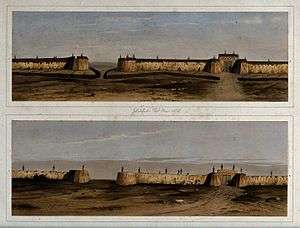Battle of Jellalabad
The Battle of Jellalabad in 1842 was an Afghan siege of the isolated British outpost at Jellalabad (now Jalalabad) about 80 miles (130 km) east of Kabul. The siege was lifted after five months when a British counterattack routed the Afghans, driving them back to Kabul.
Battle

The outpost was no more than a wide place in the road with a fort, held by about 2,000 troops under General Sir Robert Sale. After the massacre of the British force during their retreat from Kabul in January 1842, Jellallabad was surrounded by Afghan forces which launched a series of attacks on the force. The British managed to beat off the assaults, and even captured 300 sheep from the besieging force when rations ran short. Eventually, after five months under siege, Sale mounted an attack against the Afghan forces, captured their main camp, baggage, stores, guns, and horses and the Afghans fled to Kabul.
The defence of Jellalabad made heroes of the 13th Foot (later known as the Somerset Light Infantry). It is reported that as the regiment marched back through India to return to Britain every garrison fired a ten gun salute in its honour. Queen Victoria directed that the regiment be made Light Infantry, carry the additional title of "Prince Albert's Own" and wear a badge depicting the walls of the town with the word “Jellalabad”.[1] The army barracks in Taunton, the county town of Somerset, was named Jellalabad Barracks after the battle and that area of the town is still known as 'Jellalabad'.
W. L. Walton a landscape artist, working in London, who exhibited between 1834 and 1855, made the lithographic plates for General Sale's Defence of Jalalabad (c. 1845).[2]
Order of Battle
The British order of battle was;
British Army
- 13th (1st Somersetshire, Prince Albert's Light Infantry) Regiment of Foot
Bengal Presidency Army
- Squadron from 1st Horse (Skinner's Horse)
- 35th Bengal Native Infantry
- Shah Shujah's Sappers
- Artillery troops from the Bengal Field Artillery
| Wikimedia Commons has media related to Battle of Jellalabad. |
References
- www.britishbattles.com
- "W. L. Walton and General Sale's Defence of Jalalbad (c. 1845)". Leicester Galleries. Retrieved 21 January 2017.
